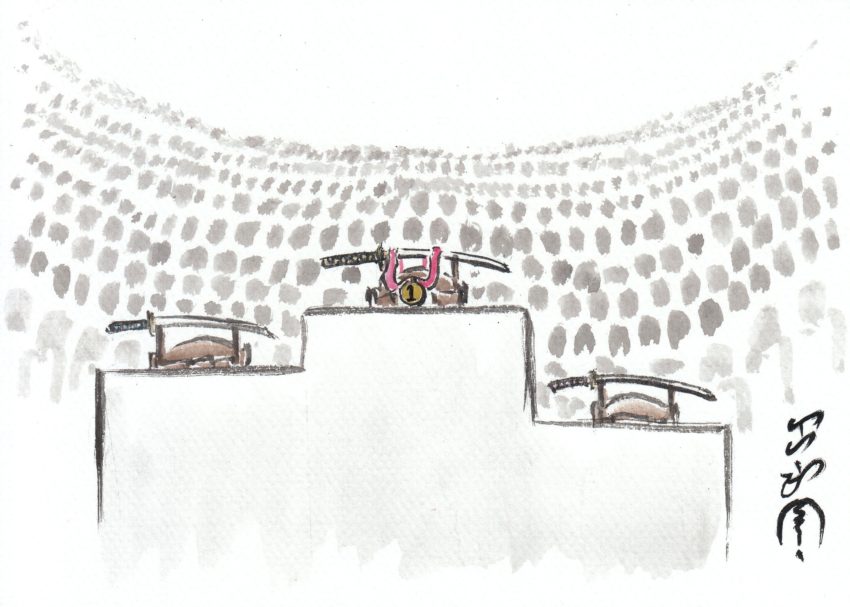Conan The Barbarian may be well-known for answering the question: “What is best in life?” But this article is more concerned, specifically, with answering the question of “what are the best Japanese swords in life?” To answer this question, we will approach it by considering specific categories and giving an assessment of the best blade for that particular group.
Do you agree that we’ve found the best Japanese swords in the following categories?
The Best Reproduction of a Sword
Anyone familiar with The Last Samurai ought to recognize the name “Nathan Algren.” That was Tom Cruise’s character in a movie where an American soldier is taught the ways of BushidoBUSHIDO 武士道 "way of the warrior" learn more.... Ten Ryu’s Capt. Nathan Algren samuraiSAMURAI 侍 "warrior serving a lord" learn more... sword is a hand-forged replica of the tachiTACHI 太刀 "great sword" learn more... that Captain Algren brought into battle. The 1060 full tang carbon steel blade extends out to 28 inches and is just over a quarter-inch thick. The 10.5-inch long tsukaTSUKA 柄 "handle or hilt" learn more... comes wrapped with silk.
The weapon also features a mirror finish that was achieved by triple-polishing. It bears an engraving of Japanese horimono. This item neither rattles around nor wiggles when used, and it boasts exceptional balance and gripping. While the blade is sharp enough for most people’s tastes, achieving a razor sharpness will take a little work. Once finished, you’ll have a true work of art in your collection.
The Most Expensive Sword in Recorded History
When it comes to discerning which blades could be considered among the best Japanese swords in history, some aficionados will set define “best” as whatever is worth the most money. A quick glimpse at record-setting auctions reveals that the most expensive Japanese sword ever sold at auction was a 13th Century katanaKATANA 刀 "sword" learn more... originating from the Kamakura area.
This weapon was among the 1,100 Japanese swords put up for auction by the state of Dr. Walter Ames Compton in 1992. The blade ended up going to a Mr. Inami for a total of $418,000, which would translate to $757,351.65 in today’s dollars. Is it the best? Perhaps; it’s certainly the priciest. That’s got to be worth something.
The Rarest Japanese Sword
While some people might define the best Japanese swords by whichever fetched the most money or most closely resembles another blade as the best blade, the rarest Japanese sword would have to be the one with the most value but that has gone missing. With this in mind, when searching for the absolute best Japanese swords, the Honjo Masamune must be named.
The “Honjo” was made by Masamune, arguably Japan’s most legendary swordsmith, and a name that will be discussed more further down this page. The Honjo gets its name by virtue of being forged by Masamune and claimed by Honjo Shigenaga as a spoil of war during 1561’s battle of Kawanakajima. Although Honjo acquired the blade with a few new chips after skirmishing with its unnamed prior wielder, the weapon retained the exceptional craftsmanship that Masamune was known for.
Shigenaga remained the weapon’s wielder until he was deployed to Fushimi Castle, Bunroku somewhere between 1592 and 1595. He was forced to sell the weapon to Hideyoshi’s nephew and retainer Toyotomi Hidetsugu. (The price was actually a paltry sum when compared to a later appraisal of the blade.)
Hidetsugu would later give the blade over to Hideyoshi, who granted it to Shimazu Yoshihiro, who then handed it off to the legendary Tokugawa Ieyasu. The weapon would remain in the hands of the Tokugawa clan, specifically its Kii branch, until the events of World War 2, some 400 years after it was forged.
After the United States of America defeated Japan, Prince Tokugawa Iemasa tried to save a bundle of precious Japanese swords by sequestering them within a police station. A misunderstanding in January of 1946 led to the weapons being lost, with a false or misheard name being used by the party receiving the weapons from the police bringing the blades in.
The Honjo Masamune remains missing to this day. If you come across it at a flea market or something, let us know.
“Everyone knows that the best Japanese swords were made by legendary swordsmiths!”
When it comes to discussing the greatest swordsmiths who ever lived, those responsible for the most perfect examples of what a Japanese sword should be, two major names come to mind: Muramasa and Masamune. While both of these men were nearly divine beings when it came to making a blade, it could be argued that their divinity came from two different sources.
Why Muramasa Might Be the Best
While Muramasa was a certifiable talent when it came to the forge, it could also be argued that he was certifiably unhinged. Stories claim that Muramasa was a man known for having a hair-trigger of a temper that would cause him explode as violently as the bodies his weapons were used against. Those stories further go on to claim that Muramasa put a little bit of himself into every blade he forged, always beseeching the kamiKAMI 神 "god" learn more... to impart great destructive power into his wares.
Horror stories arose of Muramasa-wielders being driven by the weapon’s murderous intent, induced to kill anyone they could find. Or, in the absence of a warm body filled with blood to spill, owners would find themselves turning the weapon on themselves, satisfying the cursed blade while also receiving a blissful if final escape from its malevolent edge.
Other stories claim that, once drawn, a Muramasa could not be resheathed until it had been dipped in fresh blood. Unsurprisingly, efforts to destroy legitimate Muramasas (due to the practice of using them against Tokugawa’s closest loved ones) or to forge fakes means that most of Muramasa’s handiwork has been relegated to legend, rather than placed on display within museums.
Why Masamune Might Be the Best
If Muramasa gained his divine prowess as a smith from demonic forces, Masamune must surely have gained his from the heavens above. Where stories of Muramasa’s blades are often filled with carnage, indiscriminate slaughter and sorrow, stories of Masamune’s blades are usually filled with piety, precision and unparalleled craftsmanship. Unlike Muramasa’s handiwork, several authentic Masamune blades are housed within museums and are sometimes put on display. These include the Fudo, Musashi, Hocho, Kotegiri and even one that was handed over to President Truman.
The Tenka-Goken
No discussion of the best Japanese swords would be complete without addressing five blades with “best” in their communal name. Tenka-Goken translates as “The Five Best Swords Under Heaven” and is a term hailing from the Muromachi Period (1333 to 1573). This group of blades consists of three National Treasures of Japan, one piece of Imperial Property, and a relic of Nichiren Buddhism.
- Dojigiri, the “Slayer of Shuten-doji,” is a nearly-32-inch long weapon forged by Hoki-no-Kuni Yasutsuna somewhere around the 10th to 12th centuries. Its name comes from the legend that Minamoto no Yorimitsu used it to decapitate the demon lord Shuten-doji. It has also been nicknamed the “yokozuna of Japanese swords” due to its perfection, status as the oldest surviving katana, craftsmanship and role in legends. Dojigiri is a Japanese National Treasure and resides within Tokyo National Museum.
- Onimaru, the “Demon,” is a nearly-31-inch-long tachi forged by Awataguchi Sakon-no-Shogen Kunitsuna. In addition to being, along with Odenta and Futatsu-mei, part of the trio of blades wielded by Ashikaga shoguns, it is mentioned in the epic Taiheki. In this story, Onimaru moves of its own accord to slay an oni that had cursed Hojo Tokimasa, thus earning its name. Onimaru is property of the Japanese Imperial family.
- Mikazuki, the “Crescent Moon,” is a 31.5-inch-long tachi forged by Sanjo Kokaji Munechika somewhere around the 10th to 12th centuries. Its name came from its tempered pattern of crescent moon shapes. In the Noh play Kojaki, it is said that Mikazuki’s exceptional quality came as a result of Munechika, its smith, being visited by Inari Okami, the Japanese god of foxes, prosperity, fertility, success, rice and many other major aspects of Japanese civilization. Like the Dojigiri, Mikazuki resides within the Tokyo National Museum as a National Treasure.
- Odenta, “Denta’s Best Sword,” is a 26-inch-long tachi forged by Miike Denta Mitsuyo. As previously mentioned, it was one of three blades carried by shoguns belonging to clan Ashikaga. When the shogunate collapsed, Maeda Toshiie, of clan Maeda, claimed the blade as his own. One legend claims that this weapon healed Toshiie’s daughter and another claims that birds refuse to fly or roost near the place it is stored. Odenta is considered a National Treasure of Japan and is cared for by the Maeda Ikutokukai cultural foundation.
- Juzumaru, the “Rosary,” is a 32-inch-long tachi forged by Aoe Tsunetsugu and once owned by Nichiren, a Japanese Buddhist who founded his own branch of Buddhism. Juzumaru’s name comes Nichiren’s decision to decorate it with a Buddhist rosary to cleansing evil. Today, Juzumaru is housed within Amagasaki’s Honkoji Temple, where it remains classified as an Important Cultural Property.
The Best Japanese Swords for Collector and Buyer Alike
Another approach to defining the “best” Japanese sword is whichever sword looks the best without breaking your wallet. It is with these conditions in mind that we suggest anything fabricated by Hanwei or Thaitsuki, especially if you just want a show piece and not something you intend to show off by hacking up melons or water bottles. These brands feature some quality blades that can be acquired for less than $1,000.
And to wrap up, it’s awfully hard to say definitively what the best Japanese sword ever is. We hope that you agree that, whatever your own definition of “best” may be, that one of the legendary blades on this page is a serious contender.

